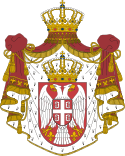- Constitution of Serbia
-
Serbia 
This article is part of the series:
Politics and government of
SerbiaConstitutionParliamentJudiciaryDivisionsLocal government
The Constitution of the Republic of Serbia (Serbian: Устав Републике Србије / Ustav Rеpublike Srbije) is Serbia's fundamental law. The current constitution was approved in a constitutional referendum, held from on 28–29 October 2006. It was officially proclaimed by the National Assembly of Serbia on 8 November 2006,[1] replacing the Constitution of 1990.[2]
The Constitution contains a preamble, 206 articles, and no amendments.
Contents
Main provisions
In the preamble, Kosovo is defined as an integral part of Serbia with substantial autonomy; the first article then defines Serbia as "the state of the Serbian people and all its citizens". It also defines Serbia as an independent state for the first time since 1918.[3]
Among the constitution's two hundred other articles are guarantees of human rights, including minority rights and the banning of capital punishment and human cloning. It also grants a small degree of autonomy for the province of Vojvodina. It assigns Serbian Cyrillic as the only alphabet for official use, while making provisions for the use of minority languages at local levels.[4] Among the differences between the current constitution and its 1990 predecessor are:
- Only private, corporate and public property is acknowledged; social assets cease to exist and shall be transferred to private owners.
- Foreign citizens are permitted to own property.
- Reappointment of judges
- The President is the Commander in Chief of the military.
- The constitution mentions "European values and standards" for the first time.
- Full independence is granted to the National Bank of Serbia.
- As part of a process of decentralization, the granting of municipal properties' ownership rights to local municipalities.
- The province of Vojvodina is granted economic autonomy.
- The adoption of the official anthem, Bože pravde (God of Justice).
- Special protection for the rights of consumers, mothers, children and minorities.
- Greater freedom of information.
- Marriage is defined as the "union between a man and a woman"
Kosovo
The constitution defines the Autonomous Province of Kosovo and Metohija as the integral part of Serbia, but with "substantial autonomy". Under the opinion of the Venice Commission in respect to substantial autonomy of Kosovo, an examination of The Constitution makes it clear that this fundamental autonomy is not at all guaranteed at the constitutional level, as the constitution delegates almost every important aspect of this autonomy to the legislature.[5]
Official language
Under the constitution the Serbian language is the only official language, and the Serbian Cyrillic alphabet is the only one in official use. Under the Constitution of 1990 the official language was Serbo-Croatian, and both Serbian Cyrillic and Latin alphabets were in official use.
Previous constitutions
Serbia has a long constitutional tradition. The first Serbian constitution — St. Sava's Nomocanon[6][7][8][not in citation given] was from 1219, enacted by Saint Sava. This legal act was well developed. St. Sava's Nomocanon was the compilation of Civil law, based on Roman Law[9][10] and Canon law, based on Ecumenical Councils and its basic purpose was to organize functioning of the young Serbian kingdom and the Serbian church. Afterwards it was Dušan's Code[11] enacted in 1349 and added in 1354 by Tsar Dušan. The Code was based on Roman-Byzantine law. The legal transplanting is notable with the articles 171 and 172 of Dušan's Code, which regulated the juridical independence. They were taken from the Byzantine code Basilika (book VII, 1, 16-17). The following Serbian constitutions were enacted during the Serbian Principality and the Serbian Kingdom periods (1835, 1838, 1869, 1888, 1901 and 1903), than during the Socialist Republic of Serbia (1947, 1963 and 1974) and the Republic of Serbia in 1990.
See also
- Serbian constitutional referendum, 2006
- Constitutional status of Kosovo
References
- ^ "Second special sitting of the national assembly of the Republic of Serbia in 2006". Parliament of Serbia official website. http://www.parlament.gov.rs/content/eng/aktivnosti/skupstinske_detalji.asp?Id=1104&t=A.
- ^ "Rare unity over Serb constitution", BBC News, 30 October 2006.
- ^ Katarina Kratovac (27 October 2006). "Serbia votes in referendum on Kosovo". Yahoo! News. http://news.yahoo.com/s/ap/20061027/ap_on_re_eu/serbia_referendum. Retrieved 2006-10-30.[dead link] (Link dead as of 15 January 2007)
- ^ "Šta donosi predlog novog ustava Srbije" (in Serbian). 30 September 2006. http://www.b92.net/info/dokumenti/index.php?nav_id=213697.
- ^ Opinion on the Constitution of Serbia adopted by the Commission at its 70th plenary session (Venice, 17-18 March 2007)
- ^ http://www.alanwatson.org/sr/petarzoric.pdf
- ^ http://www.search.com/reference/Nomocanon
- ^ http://books.google.se/books?id=QDFVUDmAIqIC&pg=PA118
- ^ http://www.constitution.org/sps/sps.htm
- ^ http://web.upmf-grenoble.fr/Haiti/Cours/Ak/
- ^ http://www.dusanov-zakonik.com/indexe.html
External links
- Constitution of Republic of Serbia in HTML format
- Constitution of Republic of Serbia in PDF format
- Previous Constitution of Serbia (1990)
- Serbian Constitutional History (Part I)
States with limited
recognition- Abkhazia
- Kosovo
- Nagorno-Karabakh
- Northern Cyprus
- South Ossetia
- Transnistria
Dependencies
and other territoriesOther entities - European Union
- Sovereign Military Order of Malta
Categories:- Serbian law
- Legal history of Serbia
- Constitutions by country
- Politics of Serbia
Wikimedia Foundation. 2010.
